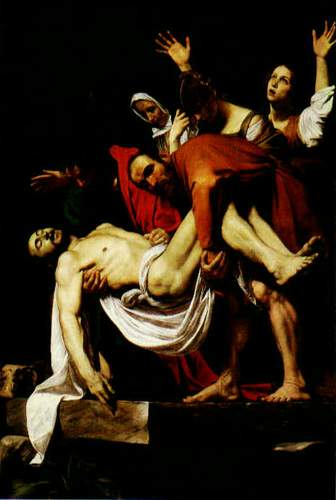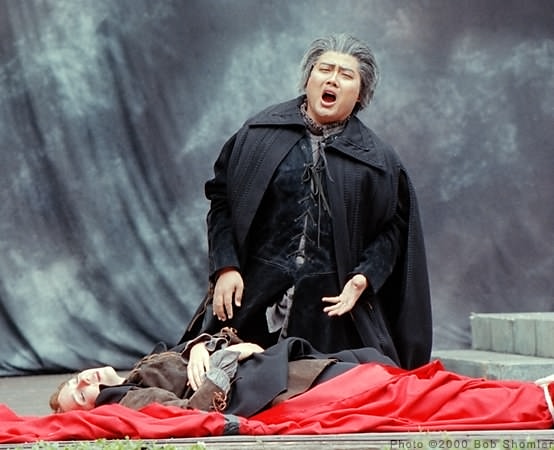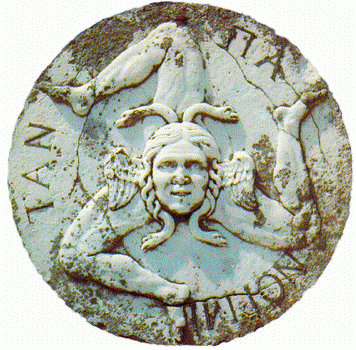
Caravaggio: Deposizione nel sepolcro Pinacoteca Vaticana
The Three Maries
Iakov Levi
Caravaggio and the Deposizione nel sepolcro
Most successful sublimations are, of course, part and parcel of cultural trends and become unrecognizable as sexual derivatives. (Erik H. Erikson, Childhood and Society)

Caravaggio: Deposizione nel sepolcro Pinacoteca Vaticana
The Three Maries
Freud has shown how the child believes that the female had had a penis
like his own, that she has been castrated by the father and, instead of
a penis, she now has a wound (1).
Freud has also evidenced how "penis" and "child" are psychically equivalent.
With Abraham's words
Freud has shown that besides the idea of motion and penis in
the sense of gifts there is still a third idea which is identified with
both of them, namely, that of a child. Infantile theories of procreation
and birth adequately explain this connection.
(2).
Freud has also shown that the number three is the symbol of the penis (3).
The little girl now cherishes the hope of getting a child from her
father as a substitute for the penis not granted her, and this again in
the sense of gift
Therefore, three women is equivalent to one female penis, which in
children fantasy is like the masculine one (Cf.
Three Women: the Penis).
In this work of art we can see how the female castration trauma is
expressed in two subsequent acts, which are one.
In the upper part of the painting, Three Maries represent the female
penis. Three and women = penis and female. The substance of the penis (female) is hinted in the condensation of the same representation.
That was the beginning. Once the member was there. Here it is: The Three
Maries.
The central scene shows us how the Son = penis is taken from them, and he
is deposited into the sepulchre. Telling us, in this way, how the number three has
been castrated. Furthermore, in our unconscious, death and castration are equivalent concepts.
As Nietzsche said: “The non - being is unthinkable”
(Unpublished Writings, 3[91]). And Freud: "It is true that the statement 'All men are mortal' is paraded in text-books of logic as an example of a general proposition; but no human being really grasps it, and our unconscious has as little use now as it ever had for the idea of its own mortality...." ("The Uncanny" [Das Unheimliche], 1919).
The terror of death is a displacement of the dread of castration. In our unconscious, castration and death are synonymous, as we can easily infer from “Death”, which is always represented as a skeleton
holding a scythe.
As pointed by Abraham, a son is psychically equivalent to the woman's missing member. Henceforth, being barren is equivalent to being castrated -dead. Equivalence confirmed by the Bible, as is written: "[Rachel] said to Jacob, 'Give me children, or I am dead'" (Gen. 30:1).
Death and the castrated member are condensed in the representation of the dead Christ. Works of art use the same mechanisms of dreams: condensation, inversion, and isolation.
The magnitude of the work of art consists in giving expression, in a subliminal way, to the
libido
fixated
in the traumatic event.
Art relieves the sufferance inherent in the energetic accumulation
of the repression.
Therefore, the latent content expressed in Caravaggio's
painting, which is manifested in the three women's grief, is the tragedy
of female castration.
The deep grief of the Three Maries, who are one sole penis, is equivalent
to that of Rigoletto
(4), himself the castrated penis of Gilda.
The scene represented by Caravaggio is, therefore, equivalent to the following:


The repetition of the same concept. Three = the penis. Serpents = the penis (5)
I should like, however, to devote a few words to one symbol, which , as it were, falls outside this class -- the number 3. Whether this number owes its sacred character to this symbolic connection remains undecided. But what seems certain is that a number of tripartite things that occur in nature- the clover leaf, for instance - owe their use for coats of arms and emblems to this symbolic meaning. Similarly, the tripartite lily - the so called fleur de lis and the remarkable heraldic device of two islands so far apart as Sicily and the Isle of Man - the triskeles (three bent legs radiating from a center) - seem to be the stylized versions of the male genitals (6)
Links:
Caravaggio, Clitorectomy and the Talion of the Woman
Caravaggio and La Madonna del serpente
Truth Is a Woman: Bernini - Giorgione - Manet
Three Women: the Penis
Cinderella and "The Puss with the Boots"
Medusa, the Female Genital and the Nazis
NOTES
(1) Sigmund Freud, "The History of an Infantile Neurosis", in The Standard Edition of the Complete Works of Sigmund Freud, Ed. and Trans. J. Strachey, Hogarth Press, London 1964, Vol.17, pp.121-2; see also K. Abraham, "The Female Castration Complex" (1920), in Selected Papers of Karl Abraham, with an introductory memoir by Ernest Jones, Translated by D.Bryan and A.Strachey, Published by Leonard & Virginia Woolf at the Hogart Press, London 1927, pp. 338 - 369.
(2) Karl Abraham, "The Female Castration Complex" (1920), in op.cit., p.343.
(3) S. Freud, "Symbolism in Dreams", in Introductory Lectures on Psycho-Analysis (1917), Lecture 10, in The Standard Edition of the complete Psychological Works of Sigmund Freud, Tr. and Ed. James Strachey, Hogarth Press, London 1963, vol.XV, pp.163-4.
(4) Iakov Levi, "Biancaneve e altre vergini", capitolo secondo, in Scienza e psicoanalisi. Rivista multimediale di psicoanalisi e scienze applicate [entered 8 Settember 2002].
(5) For the serpent as the symbol of the penis see S.Freud, op.cit, lecture 10.
For the serpent as the symbol of the fantasized female penis, and not of the masculine one, as sustained by Freud, see Iakov Levi, "Biancaneve e altre vergini", capitolo
secondo, note number nine in Scienza e psicoanalisi.
Rivista multimediale di psicoanalisi e scienze applicate [entered
8 Settember 2002].
Freud says that the serpent is one of the "less understood" male phallic symbols.
("Introductory Lectures on Psycho - Analysis; Symbolism in Dreams", 1915 - 1917, in The Standard Edition of the Complete Works of Sigmund Freud,Ed. and Trans. J. Strachey, Hogarth Press, London 1964, Vol.15, pp.149-155).
Although Freud defines the snake as a male phallic symbol, he was induced into error by the fact, as he himself says, that the woman is fantasized having a penis similar to the masculine one.
Therefore, we should not wonder if there is some confusion on the substance of the female penis, as the child himself is very confused on this issue.
In a letter to Fliess dated the 26th July 1904 he says: “Until now I did not know what I learned from your letter-that you are using [the idea of] persistent bisexuality in your treatments. We talked about it for the first time in Nuremberg while I was still lying in bed, and you told me the case history of the woman who had dreams of gigantic snakes. At that time you were quite impressed by the idea that undercurrents in a woman might stem from the masculine part of her psyche.” (The Complete Letters of Sigmund Freud and Wilhelm Fliess 1887-1904, Translated by Jeffrey Moussaieff Masson,The Belknap Press of Harvard University Press Cambridge – Massachusetts, and London-England, 1995, p.465)
Therefore, Freud had unconsciously perceived that the right association is "serpent = phallic masculine part of the woman", namely, the clitoris as pre- vaginal phallic stage. If he had interpreted the snake as a male penis he would not have raised the question of ambisexuality in this context, and he would have interpreted the dream of the woman as a desire for the male penis.
The significance of the snake as a female phallic symbol becomes clear if we notice that in mythology the reptile is always associated with goddesses and never with gods and heros.
Herodotos knew that the snakes come from Mother Earth
LXXVIII. This was how Croesus reasoned. Meanwhile, snakes began to swarm in the outer part of the city; and when they appeared the horses, leaving their accustomed pasture, devoured them. When Croesus saw this he thought it a portent, and so it was. [2] He at once sent to the homes of the Telmessian interpreters,1 to inquire concerning it; but though his messengers came and learned from the Telmessians what the portent meant, they could not bring back word to Croesus, for he was a prisoner before they could make their voyage back to Sardis. [3] Nonetheless, this was the judgment of the Telmessians: that Croesus must expect a foreign army to attack his country, and that when it came, it would subjugate the inhabitants of the land: for the snake, they said, was the offspring of the land, but the horse was an enemy and a foreigner. This was the answer which the Telmessians gave Croesus, knowing as yet nothing of the fate of Sardis and of the king himself; but when they gave it, Croesus was already taken (Hist., I:78, Ed. A.D.Godley)."the snake, they said, was the offspring of the land, but the horse was an enemy and a foreigner".
(6) S. Freud,"Symbolism in Dreams", in op.cit., pp.163-4.